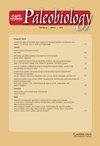有偏见的化石记录可以保存可靠的系统发育信号
IF 2.6
2区 地球科学
Q2 BIODIVERSITY CONSERVATION
引用次数: 4
摘要
摘要化石记录是出了名的不完美和有偏见,阻碍了我们将化石标本置于进化背景中的能力。对于化石记录主要由关节缺失部分组成的群体(如脊椎动物、棘皮动物、植物),保存的有限形态信息引发了人们对化石是否保留了系统发育关系的可靠证据的担忧,并为地球历史上的多样性、古生物地理学和生物地层学分析带来了不确定性。为了解决零碎的过去是否可信,我们需要评估不完整性是否会影响化石数据中包含的系统发育信息的质量。在此,我们在鳞片化石(蜥蜴、蛇、两栖动物和摩萨龙)的大型数据集(6585个标本;14417个骨骼元素)中表征了骨骼不完整性偏差。我们发现,与骨骼的其他部分相比,颌骨+腭骨、脊椎和肋骨在化石记录中出现的频率更高。化石记录中这种不完整的解剖学表现与骨骼中包含用于评估鳞片进化关系的大多数形态系统发育特征的区域存在偏见。尽管存在这种偏见,但简约和基于模型的比较分析表明,化石记录中骨骼中最常见的部分与骨骼中较罕见的部分保持着相似的系统发育信号水平。这些结果表明,有偏见的鳞片化石记录包含可靠的系统发育信息,并支持我们将不完整的化石放入生命树的能力。本文章由计算机程序翻译,如有差异,请以英文原文为准。
A biased fossil record can preserve reliable phylogenetic signal
Abstract. The fossil record is notoriously imperfect and biased in representation, hindering our ability to place fossil specimens into an evolutionary context. For groups with fossil records mostly consisting of disarticulated parts (e.g., vertebrates, echinoderms, plants), the limited morphological information preserved sparks concerns about whether fossils retain reliable evidence of phylogenetic relationships and lends uncertainty to analyses of diversification, paleobiogeography, and biostratigraphy in Earth's history. To address whether a fragmentary past can be trusted, we need to assess whether incompleteness affects the quality of phylogenetic information contained in fossil data. Herein, we characterize skeletal incompleteness bias in a large dataset (6585 specimens; 14,417 skeletal elements) of fossil squamates (lizards, snakes, amphisbaenians, and mosasaurs). We show that jaws + palatal bones, vertebrae, and ribs appear more frequently in the fossil record than other parts of the skeleton. This incomplete anatomical representation in the fossil record is biased against regions of the skeleton that contain the majority of morphological phylogenetic characters used to assess squamate evolutionary relationships. Despite this bias, parsimony- and model-based comparative analyses indicate that the most frequently occurring parts of the skeleton in the fossil record retain similar levels of phylogenetic signal as parts of the skeleton that are rarer. These results demonstrate that the biased squamate fossil record contains reliable phylogenetic information and support our ability to place incomplete fossils in the tree of life.
求助全文
通过发布文献求助,成功后即可免费获取论文全文。
去求助
来源期刊

Paleobiology
地学-古生物学
CiteScore
5.30
自引率
3.70%
发文量
38
审稿时长
>12 weeks
期刊介绍:
Paleobiology publishes original contributions of any length (but normally 10-50 manuscript pages) dealing with any aspect of biological paleontology. Emphasis is placed on biological or paleobiological processes and patterns, including macroevolution, extinction, diversification, speciation, functional morphology, bio-geography, phylogeny, paleoecology, molecular paleontology, taphonomy, natural selection and patterns of variation, abundance, and distribution in space and time, among others. Taxonomic papers are welcome if they have significant and broad applications. Papers concerning research on recent organisms and systems are appropriate if they are of particular interest to paleontologists. Papers should typically interest readers from more than one specialty. Proposals for symposium volumes should be discussed in advance with the editors.
 求助内容:
求助内容: 应助结果提醒方式:
应助结果提醒方式:


